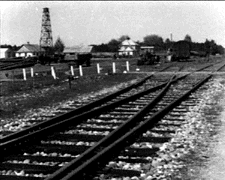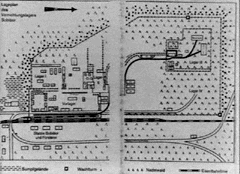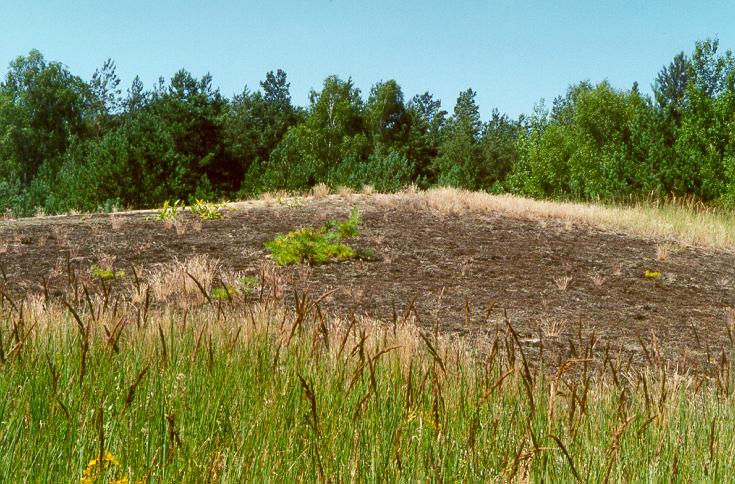  |
| Sobibor was the
second death camp out of three camps. The camp was ran by Gobocnik as
part of operation Rienhard. The location of the camp was in the Lublin
District of Eastern Poland it was about a kilometer from the river Bug.
Its general isolation and proximity to a railway is why they chose to
construct the camp there in March of 1942. The staff of the camp
consisted of about 20 SS men and about 100 Ukranian guards. |
 map
of Sobibor map
of Sobibor |
| By April 1942
the gas chambers were ready to be tested by using 250 Jews from the
Krychow Labor Camp. They were the first to be placed into the gas
chambers, which proved them operational. |
| The camp was 400
by 600 meters in a rectangular shape and enclosed by a three-meter high
barbed wire fence. Surrounding the camp was a minefield, which was made
not only to keep prisoners from escaping, but also to keep people from
approaching and contacting the prisoners. Sobibor was divided into four
sections and a pre-camp where the Jews had worked and lived while they
stayed in the camp. Lager 1 is where the Jews had worked and lived while
they stayed in the camp. Lager 2 is where the camp prison workers sorted
and stored goods. In the "barbersbarack" is where the
prisoners got their hair cut when they arrived. In between Lager 2 and Lager
3 is where the landing strip was, where airplanes could land and take
off when bringing prisoners in. Lager 3 is where the gas chambers were where the Jews had been
gassed. |
| When the camp
first started there were only three gas chambers, but later on they built
three more because three weren't killing fast enough. Before they were
gassed the prisoners were forced to strip down and were told that they
were going to take showers. |
| They didn't know
that when they arrived at the camp that they would be gassed. They were
told it was so they could make a better living. Many Jews arrived in
their best dress clothes because the Nazis told them that they were
going to be resettled in the east for a better life. |
| The Eastern
European Jews arrived in carts and were beaten along the way so they had
an idea what was about to happen to them. When they arrived,
camp prisoners wearing blue uniforms gave the new arriving Jews claim
tickets for their bags. Some people even offered the workers tips. |
| As they waited
in line to enter Lager 1, the SS would choose the stronger looking men,
women, young boys and girls to be prison workers. The rest who weren't
chosen, would enter through a gate that read "Sonderkommando
Sobibor" (special unit Sobibor). If they had a disease or
where sick than the prisoners would be taken away immediately and shot. |
| The prisoners
who worked in Lager 3 had many jobs to take care of like making gold
trinklets, boots, clothing, cleaning cars, feeding horses, sorting
clothes, unloading and cleaning the trains, cutting wood, burning
personal artifacts, cutting women's hair, and more. |
| The SS men
and the Ukranian guards marched prisoners to work every day in columns,
making them sing marching songs along the way. Prisoners were
beaten just for being out of step or not singing. Sometimes they
had to report after work at roll call to receive punishments for what
they did during the day. While they were being hit they were
forced to call out the number of hits, if they didn't shout loud enough
or if they lost count then the punishment would start all over or they
would be beaten to death. Everyone at roll call was forced to
watch their fellow inmates be beaten to death. |
| Their were 150 women out
of 600 men who worked at the camp. Many prisoners became couples
and they had dancing parties while the prisoners got a few hours off
work to relax every once in a while.
|
| food delivering to Lager
3 was very risky. Many times the gates would open while the
prisoners were still in there and the food takers would be taken in and
never heard of again.
|
| A line made of women and
children then followed by men were walked down a path to Lager 3, as
they walked down the path they saw signs on buildings that read
"The Merry Flea" and "The Swallows Nest" and arrows
pointing in different directions saying "Showers" and
"Canteens". There were gardens planted along the path
and many statues which made Sobibor not seem like a place of death but
more like a park or a labor camp instead of a death camp.
|
| Before they reached lager 2 they passed through
buildings where they were asked to leave their handbags and take off all
of their clothes. After they did that the victims entered a
hallway type of sidewalk lined with barbed wire fences woven in and out
of the trees. The Nazis called that pathway "The
Himmlestrasse" (The Road to Heaven). The pathway was about 10
to 13 feet wide. Off to the side was a little sidewalk that led in
a different direction where the women were told to go down there into
the small building for a haircut. |
| From there, they were taken to Lager 3 for their
showers. The unknowing victims came upon a large brick building
with three separate doors leading into what appeared to be showers but
were really gas chambers. 200 people at a time were pushed into
them at a time, then the doors were then sealed shut. From the
outside in a shed, an SS officer or a Ukranian guard would start the 200
horsepower 8 cylinder engine which produced the carbon monoxide gas that
entered the room through pipes in the wall that were installed their
just for that purpose. That way up to 600 people could be killed
in about 20 minutes. |
| After letting the chambers air out, the prison workers
would then drag the bodies out and put them in carts which was a very
devastating job because many of the prisoners would find relatives in
the piles of bodies on the ground. They would wheel them away and
dump them in pits called massgraves . |
| The massgraves were 60m long 15m wide and 7m
deep. After they were full, the workers were forced to wipe out
all traces of extermination. They would burn the bodies out in the
open air. This caused enormous thick clouds of smoke and produced
a terrible odor which people could see and smell from many miles
away. This prevented the camp from being kept a secret. |
 Death mound, were the bodies were burnt after the massgraves
were full
Death mound, were the bodies were burnt after the massgraves
were full |
| The prisoners started a revolt on October 14
1943. They lured most of the Nazis in by setting traps then
stabbed them with homemade knives and axes. They killed 12 out of
17 Nazi leaders that were at the camp. the escape started just
before evening call when the gasmeister Bauer saw the body of one of the
guards. Not every prisoner wanted to take part in the revolt. Only
365 prisoners tried to escape. The machine guns and mines killed 158 of
the escapees. The others made it out safely into the woods
although all but 47 were later caught and killed. The revolt was
not as successful as planned. everyone who stayed behind was later gassed
too. |
| Many of the guards liked to play games with the
prisoners like
sewing up the prisoners pant legs and putting rats down them. If
the prisoner moved he would be beaten to death. Another one was to
force the prisoner to drink a large glass of Vodka very quickly then eat
several pounds of sausage. The SS men would force their mouth open
and urinate then see how much he threw up and they would weigh the vomit
and the SS man who got their prisoner to throw up the most would get a reward of
some type.
|